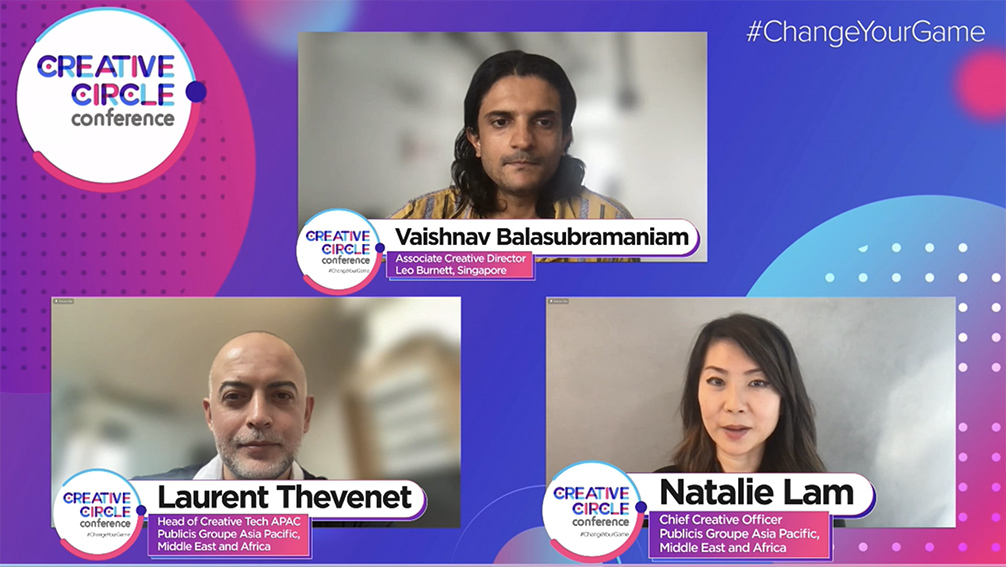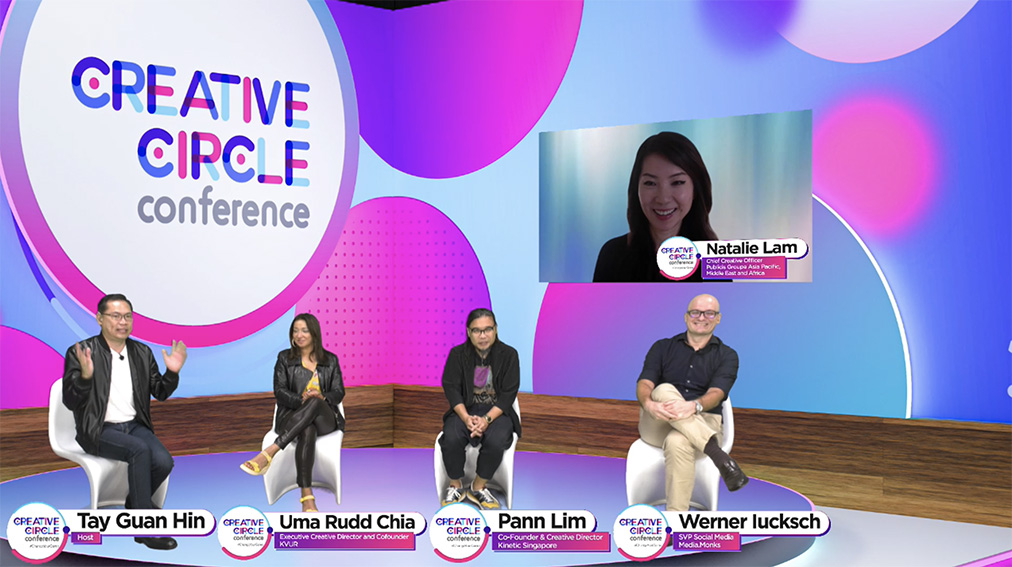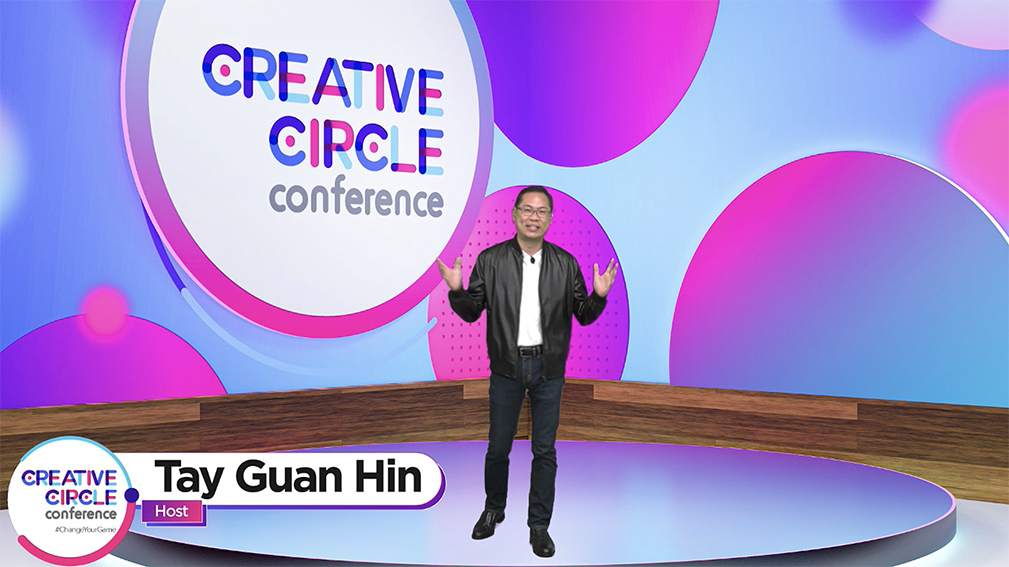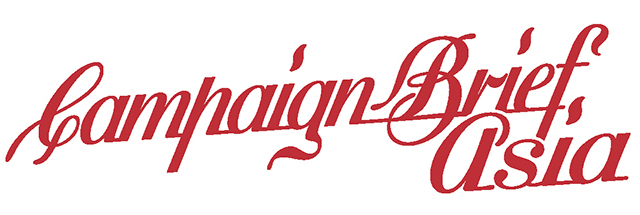Singapore Creative Circle Conference 2021: Change your game or get left behind

This year’s Singapore Creative Circle Conference focuses on game-changers. Brands, organizations, agencies, or individuals pivot despite the odds amidst today’s challenging times. They often create innovative concepts, products, or services that enhance our lives. They always managed to change their game, not allowing the game to change them.
Hosted and emceed by Tay Guan Hin, Chairman of the Creative Circle Conference 2021, Chief Creative Officer BBDO Singapore. Here are some of the key takeaways from all the speakers and panel discussions.
Creativity, not advertising.
Natalie Lam, Chief Creative Officer Asia Pacific, Middle East, and Africa, Publicis Groupe, invited two creatives from her network to challenge us to stop making ads. But to go beyond and utilize creativity to solve our client’s problems. V aishnav Balasubramaniam, ACD Leo Burnett Singapore, shared the positive effects of working on his side project called ‘Window Swap”. It’s a website that lets you gaze out of other people’s windows all over the world, is one way to get the feel of being in a new place while staying safe during the pandemic, as reported by CNN. Working on side projects helps keep us sharp, agile and can move us out of our comfort zone, but most importantly can give us more confidence.
Laurent Thevenet, head of creative Tech APAC Publicis Group Asia Pacific, Middle East, and Africa, challenged us not to take the traditional route to data-driven creativity. He shared The ‘Art of Progress.’ An art piece that combines technology, big data, and new media art forms tells HSBC’s latest chapter in its wealth growth story. The art piece turns real-time movements of Hong Kong’s Hang Seng Index into dynamic art. Natalie ended her session with an emotional, physical activation that uses technology and a camera to help Singapore-based individuals ‘reunite’ with their families in Malaysia. Through this experience, family members will once again eat breakfast together as though they are seated at the same table. Her client was not expecting this, but they used creativity to solve the problem effectively and persuasively. So with all of these, whether it’s personal side projects, we would get our creativity going and energized, or a beautiful piece of work with the latest technology or an actual action that helps people bring love to the world. To be a gamechanger is to have passionate. It’s about doing amazingly creative work. It doesn’t matter what century we’re living in; what are we living in, a current, past, or future? Creativity is the core of everything that we do.
Designing for Sustainability.
Sustainability can sound peachy if not done correctly. Today’s culture of convenience is contributing a lot to waste. So Kinetic’s solution was to create a real-life exhibition called the [Not-So] convenience store. It’s probably the world’s first convenience store that promotes inconvenience.
This exhibition is an unexpected and surprising reminder that our perception of convenience is destroying our world. Designing for Sustainability can be a game-changer for brands who believe in this purpose.
Dating your imagination.
Uma Rudd Chia, Co-Founder/ Executive Creative Director, KVUR, said that Jonathan Driggs, the principal of Hyper Island, told her the relationship between the agency and the client is like that of a “dater,” and the agency is like their dating coach. The customer and consumer target audience are the prospects, the brand wants to date them, and the agency gives guidance and advice to the data on how to date them. The first rule of dating is it’s where the prospects are. We can’t be sitting on a bridge alone, hoping they’ll come to you. We need to be where they are to win their hearts, which is why “dating my imagination” is essential because we need to be where the prospects are by playing in the space of their imagination. While the world went into lockdown, the digital world expanded in ways beyond our imagination, and now our consumer’s imagination is in the digital world. So how do we meet them there? Uma shared three game-changing insights. 1) From Storytelling to experiential brands. 2) From being influenced by famous people to hanging out with virtual characters. 3) From selling real products to NFTs. Uma believes that digital space like “outer space” is the new frontier for advertising is left open and unexplored, which leaves us ample opportunities to conquer.
Creative API- Putting Creativity in the Heart of the Process.
Werner Iucksch, SVP Social Media APAC, Media.Monks, stressed that working together could help change our game. Culture keeps changing; technology keeps changing, where we work has changed already, the types of companies competing for briefs have changed. The kind of work we need to deliver for our clients is digital integration: a mix of website and platform build social media, VR, AR, perhaps virtual events, eCommerce, gaming, film, CRM, etc. So we need to brief differently; the channel mix is vast and specialized. It’s impossible to have a team in a single office that can deliver best-in-class work in all of these areas.
Creative API enables fair distribution and flexibility in diverse teams. We connect team members with complementary skills at scale, wherever they may be. For example, we can connect the creative leader of the project with gaming experts, and organizations can connect with the art director with a UX UI designer. By connecting the strategist with the Social Media Insights people, we can consult by providing guidance. We can also connect at an operational level that makes them work better together. So, the teams are faster, more flexible, more cost-efficient, and ultimately produce higher quality, creative content.
Highlights of the panel discussion.

When clients want a typical campaign, where do we start?
Lam: I’m still going to first start with “What is the purpose”? Because a lot of times, it’s always a lot easier on a client-side to say, okay, we need a campaign. We need a 30sec spot. We need a KV but, let’s start with a purpose. Because often, if you have an objective, you will have a purpose. There are very predictable formulas that may not always solve it. And we always like to present other solutions besides the typical boxes that we have to play in. To see other solutions, I believe that we must have the best intention for our clients. A lot of my clients will really appreciate us proposing different solutions.
Sometimes we also start with taking a step back to think. Have we exhausted all the different best solutions that are the most relevant?
Pann Lim: Agree? The purpose is essential. I think it gives us where the goalposts are. I feel that it’s one of the metrics that I put in. So, for every single project, big or small, that is definitely the starting point.
Chia: I totally agree with that. I liked the idea of how to move forward; you got to start and work backward. So, you start at the end, what is the objective right? What do you want, what is the end result you want to achieve? And then you start moving backward too. Especially for creatives, we’re all guilty of going after what’s shiny versus going after solving the problem. But, as I mature as a creative, the first thing I want to tell young creators is to think about solving the problem and not think about how you can use the shiniest toy you saw yesterday.
Iucksch: I think a lot of times, the clients that are worthwhile keeping are the ones that want to be challenged. They go to the agency because the agency can think from a different perspective. Many times will entail going towards challenging what the deliverable is. That’s how we can mitigate a lot of value, not only to the immediate job that we’re doing but to the relationship into the business and as a consequence to our careers as well.
Can you share with us some of the challenges agencies face when it comes to ways of working to unlock creativity? Can you share tips on how to overcome this?
Iucksch: The biggest challenge by far is stagnation. The tip is don’t wait until the project is far ahead. And then start thinking about who you might bring in to collaborate. Don’t wait for someone to tell you that you might want to look for someone else to collaborate with. Don’t wait until the brief comes to start trying to build a network of people that might complement your skill. The point is to do this constantly, and taking the initiative is the most important thing we can bring to work every day. If we have attitude and the right mentality and add brains, we don’t have to do creativity alone. Then we become like a hive, which will help us develop creativity, in our jobs, even in our lives.
Chia: In my new agency, we tried to do away with traditional advertising models. Typically, it would be best to have an art director and a copywriter, which make up the basic creative team. I don’t think that works anymore. So I try to work with hybrid people. Everyone’s got different talents, and at different points, you’re collaborating with different groups of people. Sometimes it’s the copywriter and the art director collaborating with a creative technologist, or I’m sitting down with somebody who does coding, and we’re working on something new together. I think that’s the unique way we need to work. I am a big fan of the starfish leadership, where instead of having a hierarchy, you’ve got everybody doing different things, and sometimes you learn from each other. When you lose one little tentacle, the other new one can grow because it’s easier to do that. One of the things that I do want to add is the processes.
I’m a big believer in processes, but I feel that processes can only work in a creative environment if we put a process in place. The objective of the process is to get to an end result, to become more creative. If we think the process aims to follow the process, at any point where we fail to follow the process, we believe that we failed. And failure kills the creativity of afraid. Fear of failure kills creativity.
Lam: What I enjoyed the most about being creative is collaborating and just being crazy. Be silly with the people you work with. Coming up with the idea. So that’s how I work with everybody. The key is that we all bring something to the table. I can tell you what I’m good at and what I’m terrible at. Knowing that in a team and respecting what each person is good at, and then what they could offer and listen to maximize what they bring to the table and together, I think, you know, well, and, well, we’re working, collaborating.
We can laugh. We can be honest with each other, regardless of titles. I think that’s important. I’ve seen it often while I was in a junior position where everybody was second-guessing what their bosses were thinking. Right. They’re afraid to say what they believe in. And I think that kills creativity the most. If you believe in it, be honest. I think everybody respects that. So that’s how I like to work with everybody. Because as, as soon as someone starts second-guessing what someone else would think, I don’t think that’s the best use of everybody’s time. We all work 24/7. So why are we killing ourselves? You know, trying to hide what we believe in?
Pann Lim: Kinetic Singapore is fortunate to be able to stay this small size. There are now between 16 to 18 of us. This is a size that I love. I feel that I’m able to talk to everyone every day. When the agency is too big, you can’t have lunch or dinner with people. If they start going out in groups, they like to talk. They will talk about each other’s work. When people talk, they gossip about all the different projects. If their discussions are always positive, that’s great. But as humans, nothing is always positive. So I find a sweet spot. Even when we go on company dinners, we can have two big round tables, bringing their spouses to mingle. We can still go around, and we can still chit-chat and can still behave like a family. So that’s my starting point.
I don’t usually hire the most talented person on the team. I want the best person: in terms of collaboration, in terms of mindset. And I look at it as an ecosystem. I don’t want to introduce like a snake-head hit into a pond. Snake-Head is a very strong fish, but I don’t need that kind of fish. I need everyone to come together. And as a collective, we become powerful. There’s no real boss in this company. I sit together with everybody. We go to lunch together. The worst thing that happened is I look at leadership as a triangle; the higher you climb, it’s just a very small space at the top. And when you go out for lunch, nobody wants to ask you out for lunch. They try to run away from you. I’m not too fond of that. So currently, we’ve been running this way for the past 22 years, and it’s been going okay. And I hope it continues this way.
What does it take to be a game-changer?
Lam: Always question what else can you do? So you’re never reusing what you know how to do. Never stay in a comfortable spot.
Iucksch: The word is initiative. Don’t wait. Think of something. Go ahead. Please don’t wait for people to tell you it’s okay or not. Ask for forgiveness. That’s the spirit of how you can change the way you think.
Pann Lim: Set your standards really high and just keep trying. That’s to me, is how you will eventually change a game.
Chia: Think crazy. Look at Elon Musk and Einstein; Einstein looked crazy. Elon Musk has been called crazy. As long as the world calls you crazy, when you’re aiming for these big things, and you don’t care what anybody else thinks, and you go for it, that’s how you are a game-changer.
Guan: Be crazy. Be courageous. Be adventurous. Be different. Don’t ask for permission. Ask for forgiveness later. Don’t apologize. Just go for it. And take a big risk. Be a game-changer, everyone, because the world is already full of followers.
This conference is organized by AAMS Limited, which has always been the leader in championing creativity and relevancy in Singapore’s advertising, marketing, and communication industry as part of its key objective to raise Asia’s profile.

